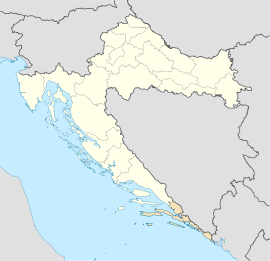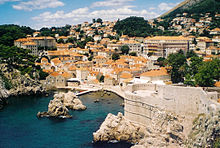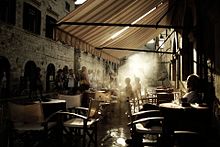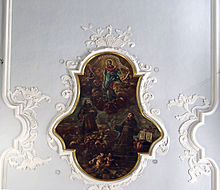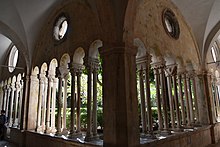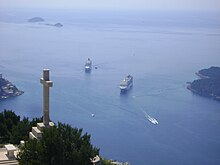Dubrovnik
| Dubrovnik | |||
|
|||
|
|
|||
| Basic data | |||
|---|---|---|---|
| State : |
|
||
| County : |
|
||
| Height : | 0 m. i. J. | ||
| Area : | 143.35 km² | ||
| Residents : | 42,615 (2011) | ||
| Population density : | 297 inhabitants per km² | ||
| Telephone code : | (+385) 020 | ||
| Postal code : | 20,000 | ||
| License plate : | YOU | ||
| Boat registration : | DB | ||
| Structure and administration (status: 2013, cf. ) |
|||
| Community type : | city | ||
| Structure : | 4 districts | ||
| Mayor : | Andro Vlahušić ( HNS ) | ||
| Coalition partner : | HSS, SHUS | ||
| Postal address : | Pred Dvorom 1 20000 Dubrovnik |
||
| Website : | |||
| Others | |||
| Patron saint : | St. Blaise (Sv.Vlaho) | ||
| City Festival : | 3 February | ||
 The old town of Dubrovnik |
|||
Dubrovnik [ ˈdubrɔ̞ːʋnik ], formerly known as the Republic of Ragusa ( Latin Rausium , later Ragusium ; Italian and German Ragusa, older also Ragus ), is a city in southern Croatia on the Adriatic Sea . In 1979, the entire old town was added to the UNESCO World Heritage List .
Dubrovnik is now the administrative seat of the Dubrovnik-Neretva County (Croatian Dubrovačko-neretvanska županija ) and the seat of the Catholic Diocese of Dubrovnik . The city had 42,615 inhabitants at the 2011 census. The majority of the population are ethnic Croats (90.34% ). There are also a few Serbs and Montenegrins , Bosniaks , Albanians and a small Jewish community . The city of Dubrovnik was one of the centers in the history of the development of the Croatian language and literature. Numerous important Croatian poets , artists, scholars, mathematicians and physicists come from this city. Nowadays Dubrovnik can also be described as a cultural center of Croatia.
For centuries, Dubrovnik was an independent city-republic that had trade relations with large parts of south-eastern Europe and the Mediterranean . In addition to the name of the city, the motto “Libertas” (Latin for freedom ) is still emphasized. Today this name can be found among other things in the motto of the Dubrovnik Festival Weeks for music and theater. Also famous is the legendary saying when the Ottomans wanted to take the city, which testifies to the residents' pronounced and forward-looking understanding of freedom. The Dubrovnik people (Croat. Dubrovčani ) confessed to the words of their poet Ivan Gundulić : " Non bene pro toto libertas venditur auro " (German: "For all the gold in this world we will not sell our freedom.")
history
For the history of the city republic see also the main article Republic of Ragusa .
Antiquity
The Croatian name of the city is derived from the Slavic word dubrava (oak grove); the Romanesque name Ragusa / Rausa goes back to the name of the small island on which the first settlement (Lave, Lausa) was built.
New archaeological finds show that on the rock called Ragusa in antiquity, in the 3rd century BC An Illyrian settlement existed. With the reorganization of the Roman Empire and in particular the church administrative conditions in the middle of the 6th century, the rock was fortified around 550/560 under Justinian I , as well as a basilica intended as a bishopric with larger dimensions (31 m × 18 m) on the square of the the current cathedral. But even during the Gothic Wars of 533/534, Ragusa seems to have played a role in Belisarius's operations . At the beginning of the 7th century at the earliest, the inhabitants of the destroyed Epidaurum (today's Cavtat ) moved to the fortified island as a result of the Slavic invasions .
middle Ages

Emperor Constantine VII Porphyrogennetos (905–959, ruled 945–959) describes in his work De Administrando Imperio all the peoples of the empire, as well as those who border the empire, their origins and the history of the cities in this area. According to Porphyrogennetos, the oldest name for Dubrovnik was Lausion , which is said to have been derived from a Greek word for steep . In the course of time, the L changed into an R , from which the name Rausion and later Ragusium was formed. The following variants are also known: Rausium, Racusium, Rausa, Ragusa, Racusa . In the papal bull of Pope Benedict VIII , which was sent to the Archbishop of Dubrovnik in 1022, there is the name Labusedi , which was derived from the Latin word labes , which means fall . Therefore, from the Greek, the names come Lausion and Rausion , from the Latin, the terms Labusa and Labusedi .
After the Slavs expelled the population of Epidaurum, they settled in this city. They also founded a settlement on the mainland at the foot of the Sergiusberg opposite the island to which the Romanesque population had fled, on a piece of land that was covered by a thick oak forest. Since the oak was called dub in Slavic , the name Dubrovnik was most likely formed from it .
Over time, friendly relations developed between the island settlement and the Slavic population on the mainland. In the 12th century, the canal between the mainland and the island was filled in, causing the two settlements to grow together. Today, Dubrovnik's famous main street, the Stradun, is located here (the Placa is the filled-in inlet that separated the island from the mainland). The center of the united city later developed at this point. The Archdiocese of Ragusa was founded in 980.
Dubrovnik has been under the protection of Byzantium since its inception (a Byzantine strategist resided here for some time). At the turn of the 12th to the 13th century, Dubrovnik was allied with the Bosnian Ban Kulin . Bosnia became an important supplier of raw materials to the city (wood and metals). At the same time, important trade routes into the interior of Southeast Europe ran through Bosnia . At the time of the Crusades, the city was temporarily under the rule of Venice (1205-1358). In 1242 the city was besieged by the Mongols and the surrounding area was devastated. In 1240 and 1244 the alliance with Bosnia was renewed.
After the Zadar peace treaty in 1358 , Dubrovnik recognized the sovereignty of the Croatian-Hungarian kings and paid tribute to them until they were defeated by Mohács in 1526 . However, from 1420 onwards, delegations regularly traveled to the Ottomans , who, in addition to affirming their neutrality, brought annual tributes, most recently 12,500 ducats , paid until the Peace of Passarowitz in 1718.
After obtaining its autonomy (the Hungarian-Croatian king was only paid taxes and ships), Dubrovnik began life as an independent Republic of Ragusa . The republic managed to maintain its autonomy, and the citizens of the city elected their city council and senate.
The city's patron saint was St. Blaise (in Dubrovnik: sveti Vlaho ; otherwise Croatian: sv. Blaž ), a doctor from the time of Diocletian who, according to tradition, saved Dubrovnik from an attack by the Republic of Venice.
In 1416 the Republic of Ragusa became the first city-state in Europe to abolish slavery ; at the same time the slave trade was forbidden by law.
Ottoman era
In the 15th and 16th centuries, Dubrovnik experienced its greatest economic boom due to the profitable trade with the Ottomans in the hinterland and the coastal cities of the Mediterranean region .
Dubrovnik's merchant fleet consisted of 160 ships in the 16th century and was one of the largest in the Mediterranean at the time. The most important protecting power of the Republic of Dubrovnik was the Kingdom of Spain , the greatest threat to the independence and freedom of Dubrovnik was Venice. With the Peace of Passarowitz in 1718, the Ottomans were granted access to the Adriatic between Neum and Klek . Today this part of the coast is part of the state of Bosnia and Herzegovina and the reason that Dubrovnik is an exclave .
The crisis of the Mediterranean shipping and especially the catastrophic earthquake of 1667 led to a serious crisis from which the city-republic no longer properly recovered.
Dubrovnik was the first state in the world to internationally recognize the independence of the United States of America in 1776. In the 18th century there were over 85 consulates in Dubrovnik.
More recent history from 1800
In 1806, French soldiers under Napoleon Bonaparte occupied the city, and in 1808 Marshal Marmont proclaimed the republic to be repealed.
From 1809, Dubrovnik belonged as the Raguse department to the Illyrian provinces of Napoleonic France . Marshal Marmont became military governor with the title of Duke of Ragusa . After the Congress of Vienna it fell to the Austrian Empire and became part of the Crown Land of Dalmatia .
The Brockhaus from 1886 describes the city as a fortress, but pretty well built and, although narrow and uneven, very clean. The industry is limited to some silk and leather and a few liquor factories, as well as excellent cooking oil . A Turkish caravan comes to the local bazaar three times a week .
Even during the Habsburg rule, tourism began to develop at the beginning of the 20th century, a tram line to the New Harbor , which existed until 1970, was built, and the brother of Emperor Franz Joseph , Archduke Ferdinand Maximilian of Austria , settled on the one in front of the city Lokrum Island ( Italian Lacroma ) build a summer residence.
From 1918
From 1918 to 1941, Dubrovnik was part of the "first" Yugoslavia . The tourism developed further, first rather on an exclusive basis. Luxury villas emerged, such as B. the still existing, orientalizing Villa Šeherezada of the Estonian-American hotel and casino millionaire William D. Zimdin east of the old town. As part of the restructuring of the internal national borders, Dubrovnik became part of the Banschaft Croatia ( Banovina Hrvatska ) in 1939 due to historical reasons and the majority of the Croatian population . During the Second World War, the city came to the so-called Independent State of Croatia under Ante Pavelić .
After 1945, Dubrovnik remained part of the Croatian republic in the second Yugoslavia . In 1956, an event with significant architectural history took place in Dubrovnik: the 10th (and penultimate) from the series of CIAM congresses (Congrès Internationaux d'Architecture Moderne). The city became one of the main destinations of Adriatic tourism in the period after World War II.
During the Croatian War , the city, which is a World Heritage Site, was besieged by Serbian-Montenegrin armed forces and massively shot at. According to the Croatian Red Cross , a total of 114 civilians were killed. The material damage has now been almost completely repaired and the city is once again the most popular holiday destination in the region.
politics
City flag
The flag shows the city patron St. Blaise with a model of the old city center and a staff in his left hand. The right hand is raised to take an oath. The clothes are in the Slovak national colors red, blue, yellow and white. - The patron saint is also incorporated into a niche as a sculpture above the southern city gate.
coat of arms
Two horizontal red bars are shown in dark blue in the triangular heraldic shield . It is part of the crown from the coat of arms of Croatia .
World Mayor
The World Mayor project awarded the city of Dubrovnik and the mayoress Dubravka Šuica eighth place in the ranking of mayors in the world in 2006 . The ranking was determined by internet voting. This project aims to highlight the importance of the mayor's office.
Town twinning
Dubrovnik has city partnerships with the following cities:
-
 Ravenna ( Emilia-Romagna , Italy), since 1967
Ravenna ( Emilia-Romagna , Italy), since 1967 -
 Vukovar ( Vukovar-Srijem , Croatia), since 1993
Vukovar ( Vukovar-Srijem , Croatia), since 1993 -
 Graz ( Styria , Austria), since 1994
Graz ( Styria , Austria), since 1994 -
 Helsingborg ( Skåne län , Sweden), since 1998
Helsingborg ( Skåne län , Sweden), since 1998 -
 Ragusa ( Sicily , Italy), since 2000
Ragusa ( Sicily , Italy), since 2000 -
 Bad Homburg vor der Höhe ( Hessen , Germany), since 2002
Bad Homburg vor der Höhe ( Hessen , Germany), since 2002 -
 Sarajevo ( Bosnia and Herzegovina ), since 2006
Sarajevo ( Bosnia and Herzegovina ), since 2006 -
 Monterey ( California , USA), since 2007
Monterey ( California , USA), since 2007 -
 Rueil-Malmaison ( Île-de-France , France), since 2011
Rueil-Malmaison ( Île-de-France , France), since 2011
The city is also a member of the Federation of European Napoleonic Cities .
Culture and sights
Attractions
Dubrovnik is considered one of the most beautiful cities in the Mediterranean and is a center of tourism . The city is increasingly becoming a meeting place for the international jet set and high society . The old town is car-free except for limited delivery and resident traffic; Parking is very limited near the old town.
- The city walls of Dubrovnik are 1940 meters long and between three and six meters wide and (for a fee) completely accessible. They are the best preserved fortification system in Europe and comprise a perfectly preserved complex of public and private, sacred and secular structures from all periods of the city's history, starting with its foundation in the 7th century.
- Dubrovnik city port .
- Main promenade (the "Stradun")
- The Cathedral of the Assumption
- Sankt Blasius (Sveti Vlaho) : After the 14th century church of the city's patron saint , Blasius , was burned down in 1706, the three-nave baroque church was built on the same site in 1715 . At the high altar is the gilded statue of the saint, who carries a model of the medieval city.
- The Dominican monastery (Ulica iza medja) was founded in the 13th century and built in the 14th and 15th centuries, after which it was rebuilt several times. Just like the bell tower, the church has Romanesque , Gothic and Baroque style elements. It contains valuable paintings, including the "Saint Magdalena with Saint Blaise" by Titian . The richly decorated arcades of the cloister are in the transition from Gothic to Renaissance .
- The Franciscan monastery dates from the 14th century. A Pietà by the Petrović brothers is located above the late Gothic south portal of the church . Inside you can see a pulpit from the 15th century and the tomb of the poet Ivan Gundulić . The cloister, built in the first half of the 14th century, is Romanesque and was partially restored in the 15th century in the Gothic style.
- The Rector's Palace (first built in 1435) was destroyed by gunpowder explosions in the 15th century and then renovated in the Renaissance style. After the earthquake of 1667, baroque style elements were added during the reconstruction. In the center of the palace is the arcaded atrium and a fountain from the 15th century.
- Medieval pharmacy, from 1317, one of the oldest in Europe.
Other sights include the Roland Column , the Customs House , the Sponza Palace and the bell tower . There is also one of the oldest municipal theaters in Europe in Dubrovnik , which is still used for performances.
On the barrier island Lokrum and in the suburbs Ploce there are hospitals, here called Lazareti , in which for the first time in 1377 incoming travelers for preventive protection of the city before in Europe starting in Pest 30 days later 40 days isolated in quarantine had to stay.
The world's oldest arboretum , Arboretum Trsteno , which was created around 1492, is located near the city of Dubrovnik.
The Lovrijenac Fortress is located west of the old town on a 37 meter high cliff. The inscription on the fortress " Non bene pro toto libertas venditur auro" means "Freedom is not sold for all the gold in the world". 1301 this was first mentioned in an official document.
Lokrum Island was first mentioned in 1023 as the site of an abbey and a Benedictine monastery. In 1839 the island was bought by Archduke Maximilian of Austria and a summer house was built. Most of the plants in the garden come from Australia and South America. In 1963 the island was declared a nature reserve and in 1976 a special forest reserve. The lake Mrtvo More (Dead Sea) is directly connected to the open sea.
Events
The town festival of St. Blaise (patron saint of Dubrovnik) (Croatian Festa svetoga Vlaha ) is celebrated every year on February 3rd .
In addition, the annual Dubrovnik Summer Festival (Dubrovačke ljetne igre) has been held in the Lovrijenac Fortress in July and August since 1950, with numerous events in the field of the performing arts .

Dubrovnik as a film location
Dubrovnik is used as a filming location for numerous scenes from the fantasy television series Game of Thrones . Among other things, the Lovrijenac Fortress , the Pile Gate and parts of the city fortifications were used as locations in the HBO series, mainly for the capital King's Landing and the city of Qarth . Due to the great popularity of the series, special Game of Thrones city tours are now offered in Dubrovnik .
In February 2016 it was announced that scenes from the film Star Wars Episode VIII were being shot in Dubrovnik.
As a result of the series, there was a significant increase in tourism in Dubrovnik.
traffic
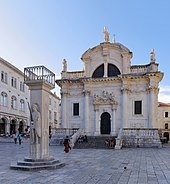
Dubrovnik has an international airport . The expansion of the A1 motorway to Dubrovnik is planned, currently (2019) it will end around 70 construction kilometers north of the city. So far, Dubrovnik can only be reached via the Croatian national road D8 ( Jadranska Magistrala ) . From the Franjo Tuđman Bridge in the west of Dubrovnik over the Rijeka Dubrovačka bay , it runs as a bypass road along the slopes above Dubrovnik and is connected to the city via two connections.
Dubrovnik never had a standard gauge railway connection. Until 1972, the terminus of the Uskoplje – Gruž line , a branch of the then Dalmatian Railway, was in the Kantafig district . A narrow-gauge tram also ran from the said train station - until it was closed due to a serious accident - to the old town in the district of Pile .
The city bus company Libertas operates buses that provide transport in Dubrovnik and the surrounding areas.
Today's main port of Dubrovnik, where cruise ships dock, is located in the northwestern part of the city of Gruž (Italian: Gravosa ). However, because of the picturesque panorama, many cruise ships anchor at the roadstead in front of the old town. Dubrovnik is seasonally overwhelmed by cruise tourists in particular; as in other cities, one speaks of overtourism . According to media reports, Dubrovnik has only allowed two cruise ships a day into the port since 2019.
sons and daughters of the town
- Mavro Vetranović (1482–1576), writer and Benedictine
- Marin Držić (Marino Darza) (1508–1567), writer
- Dinko Zlatarić (1558–1613), poet and translator of the Renaissance
- Marin Getaldić (Marino Ghetaldi) (1568–1626), mathematician
- Ivan Gundulić (Giovanni Francesco Gondola) (1589–1638), poet
- Stjepan Gradić (Stefano Gradi) (1613–1683), curia diplomat and polymath
- Rugjer Josip Bošković (Ruggero Giuseppe Boscovich) (1711–1787), Jesuit, physicist and diplomat
- Luka Sorkočević (Luca de Sorgo) (1734–1789), diplomat and composer
- Đuro Ferić (1739–1820), poet and Jesuit
- Antun Sorkočević (Antonio Sorgo) (1775–1841), composer, writer and diplomat
- Niko Pucić (Nicola Pozza) (1820–1883), politician
- Federico Seismit-Doda (1825-1893), Italian statesman
- Milan Rešetar (1860–1942), Slavist and numismatist
- Blagoje Bersa (Benito Bersa) (1873–1934), composer
- Petar Trifunović (1910–1980), chess grandmaster
- Tereza Kesovija (* 1938), singer
- Ibrica Jusić (* 1944), songwriter and musician
- Milo Hrnić (* 1950), singer
- Darrell Ubick (* 1952), arachnologist
- Dubravka Šuica (* 1957), politician
- Mario Kopić (* 1965), philosopher
- Oleg Valjalo (* 1970), politician
- Nikola Prkačin (* 1975), basketball player
- Emir Spahić (* 1980), football player
- Srđan Lakić (* 1983), football player
- Miho Bošković (* 1983), water polo player
- Maro Joković (* 1987), water polo player
- Alen Halilović (* 1996), football player
- Ana Konjuh (* 1997), tennis player
Climate table
| Dubrovnik | ||||||||||||||||||||||||||||||||||||||||||||||||
|---|---|---|---|---|---|---|---|---|---|---|---|---|---|---|---|---|---|---|---|---|---|---|---|---|---|---|---|---|---|---|---|---|---|---|---|---|---|---|---|---|---|---|---|---|---|---|---|---|
| Climate diagram | ||||||||||||||||||||||||||||||||||||||||||||||||
| ||||||||||||||||||||||||||||||||||||||||||||||||
|
Average monthly temperatures and rainfall for Dubrovnik
|
|||||||||||||||||||||||||||||||||||||||||||||||||||||||||||||||||||||||||||||||||||||||||||||||||||||||||||||||||||||||||||||||||||||||||||||||||||||||||||||||||||||
See also
literature
- Konstantin Jireček : Poselství republiky Dubrovnické k císařovně Kateřině v roce 1771, 1893
- Adriana Kremenjas-Danicic (Ed.): Roland's European Ways . Europski dom Dubrovnik, Dubrovnik 2006, ISBN 953-95338-0-5
- Krunoslav Ivanisin, Wolfgang Thaler, Ljiljana Blagojeviv (eds.): "Dobrovic in Dubrovnik - A Venture in Modern Architecture" JOVIS Verlag Berlin 2015, ISBN 978-3-86859-357-0
- Franz N. Mehling (ed.): Knaurs Kulturführer: Yugoslavia . Droemer Knaur Munich / Zurich 1984, pp. 94–98, ISBN 3-426-26135-9 .
Web links
- Official tourism website of the Dubrovnik region (German)
- UNESCO World heritage
- Extensive information on the history and outstanding personalities of Dubrovnik, English
- Information about Dubrovnik (in English) as part of the "New Economic Geography" map of the European Stability Initiative (ESI)
Individual evidence
- ↑ Tibor Zivkovic, Historical review, vol. LIV, pp. 9-25 On the foundation of Ragusa
- ↑ Ivo Goldstein, Zavod za Hrvatsku povijest, Vol. 37, 2007 Funkcija juznog jadrana u ratu bizantskog carstva protiv Ostrogota 533-555 (PDF; 132 kB)
- ↑ Gerhard Herm: The Balkans. The powder keg of Europe . Econ Verlag GmbH, Düsseldorf / Vienna / New York / Moscow, 1993, p. 153, ISBN 978-3-430-14445-2
- ↑ Gerhard Herm : The Balkans. The powder keg of Europe . Econ Verlag GmbH, Düsseldorf / Vienna / New York / Moscow, 1993, p. 153, ISBN 978-3-430-14445-2
- ↑ O Dunrovniku. Page with the town twinning at www.dubrovnik.hr ( memento from August 1, 2012 in the web archive archive.today ), accessed on May 23, 2011
- ^ Jumelage between Rueil-Malmaison and Dubrovnik. Website of the French Embassy in Croatia , accessed 23 May 2011
- ↑ Article on Spiegel Online about the Game of Thrones filming , accessed on February 5, 2015.
- ↑ Instagram posting from the official Croatia account about the Star Wars filming , accessed on March 31, 2016.
- ↑ Audio 6.02 minutes Dubrovnik drowns in tourists , by Sabine Adler , Deutschlandfunk July 3, 2019
- ↑ Andreas Lorenz-Meyer - CH Media : Cruise ships are real polluters - now ports are pulling the emergency brake. In: aargauerzeitung.ch . April 29, 2019. Retrieved April 29, 2019 .


